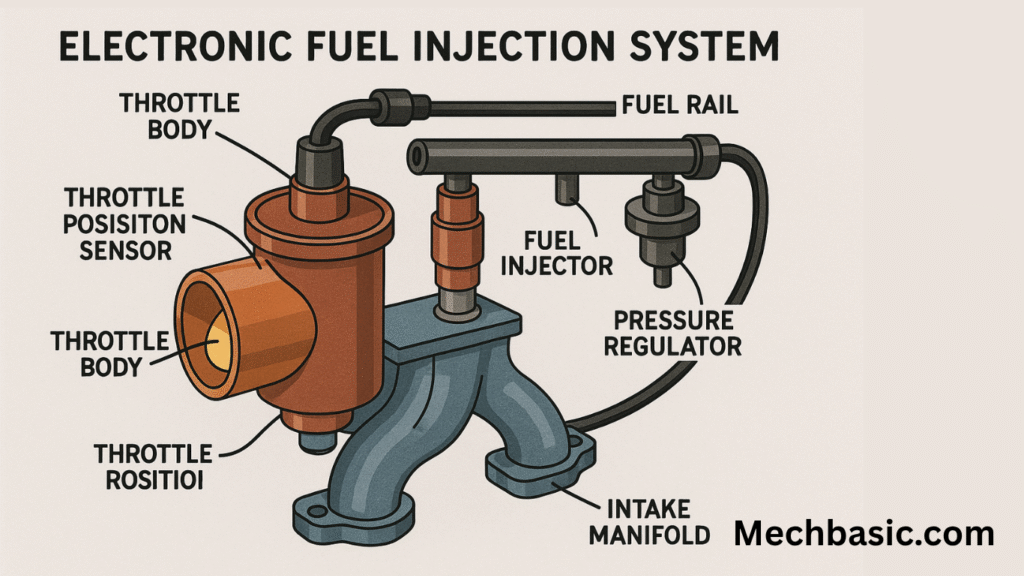In this article, we discuss the Automotive electronic injection system in detail.
In this article:
What Is Automotive Electronic Injection System?
The Electronic Injection System is a method used in modern vehicles to deliver the exact amount of fuel directly into the engine’s combustion chamber or intake manifold with the aid of electronic controls instead of mechanical components.
This results in higher engine performance, greater fuel efficiency, and lower emissions.
Main Components
1. Electronic Control Unit (ECU):
The “brain” of the system — parses signals from sensors and calculates the proper amount of fuel.
2. Fuel Injectors:
Electrically controlled valves that spray atomized fuel into the intake manifold or directly into the cylinder.
3. Fuel Pump:
Provides pressurized fuel delivery to the injectors (typically 40–60 psi).
4. Fuel Pressure Regulator:
Maintains a constant pressure for injection.
5. Mass Air Flow (MAF) Sensor or Manifold Absolute Pressure (MAP) Sensor:
Measures the amount of air entering the engine.
6. Engine Coolant Temperature Sensor (ECT):
Provides temperature data, affecting air-fuel mixture.
7. Throttle Position Sensor (TPS):
Detects throttle plate opening, adding to the mixture’s adjustment.
8. Oxygen Sensor (O₂ or Lambda):
Monitors the oxygen content in the exhaust to enable closed-loop control.
9. Other Sensors (Knock, Crankshaft, Camshaft):
Provide additional data for fine-tuning injection and ignition.
Working Principle :

- The sensors feed real-time data (load, temperature, airflow, throttle, and more) to the Electronic Control Unit (ECU).
- The ECU calculates the proper amount of fuel needed for combustion.
- The fuel pump pressurises the fuel and maintains delivery pressure.
- The fuel injectors, under electronic control, spray the right amount of atomized fuel directly into the intake manifold or cylinder.
- This results in optimized air-fuel mixture, yielding better combustion, power, and lower emissions.
- The oxygen sensor then feeds back information about the combustion process, allowing the ECU to fine-tune delivery in real time (closed loop control).
Types of Automotive Electronic Injection System
1. Single-Point Injection (SPI or Throttle Body Injection):
One injector for all cylinders — located in the throttle body.
2. Multi-Point Injection (MPI or Port Injection):
One injector per cylinder — placed close to the intake valve.
3. Sequential Multi-Point Injection (SFI):
Controlled injection for each cylinder in its respective intake stroke — for greater precision.
4. Direct Injection (GDI — Gasoline Direct Injection):
Injects fuel directly into the combustion chamber — yielding higher power, greater efficiency, and reduced emissions.
Advantages:
- Better fuel delivery and mixture control.
- Higher fuel efficiency and power output.
- Lower pollutant emissions (CO, HC, NOx).
- Easier diagnostics with OBD (On-Board Diagnostics) tools.
- Better adaptability to changing engine conditions.
Summary :
The Automotive Electronic Injection System is a sophisticated method for delivering precisely the amount of fuel needed by the engine under all operating conditions — resulting in improved performance, greater efficiency, and reduced emissions.
You tube video on Electronic fuel injection system.
FAQ Section:
What is an Electronic Fuel Injection (EFI) system?
EFI is a system that injects fuel directly into the engine’s intake manifold using electronic controls for precise fuel delivery.
How does an EFI system work?
Sensors monitor engine conditions, and the ECU (Engine Control Unit) calculates the correct fuel-air mixture, then sends signals to injectors to deliver fuel.
What are the advantages of EFI over carburetors?
EFI offers better fuel efficiency, lower emissions, smoother engine performance, and easier starting, especially in cold weather.
What components make up an EFI system?
Key components include fuel injectors, fuel pump, ECU, throttle body, sensors (like oxygen, MAP, TPS), and fuel pressure regulator.
Why is EFI more fuel-efficient?
Because it delivers the precise amount of fuel needed based on real-time engine data, reducing wastage and improving combustion.
Can EFI systems be repaired or must they be replaced?
Most components can be diagnosed and repaired, but some sensors or control units may need replacement if faulty.
How do you know if your EFI system has a problem?
Symptoms include poor fuel economy, engine misfires, rough idling, difficulty starting, or a check engine light.
Is EFI maintenance-intensive?
No, EFI systems are generally low-maintenance but benefit from periodic checks and cleaning of injectors and sensors.
Can you upgrade a carbureted engine to EFI?
Yes, conversion kits are available, but it involves significant modification and cost.
Does EFI improve engine performance?
Yes, it enhances throttle response, power output, and overall drivability through accurate fuel delivery.
Other courses:



